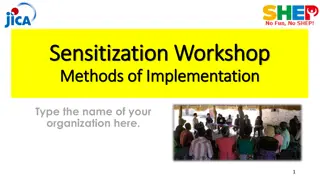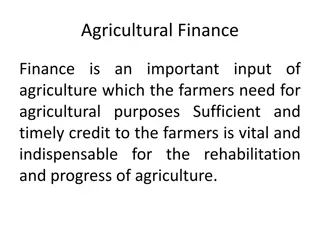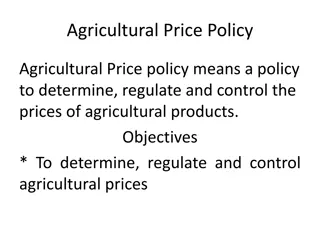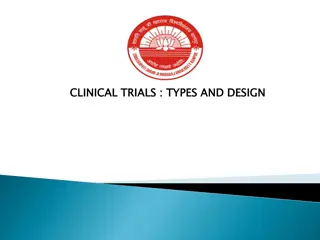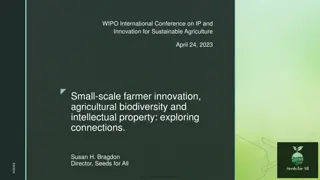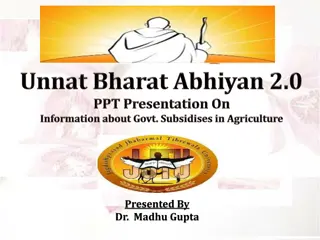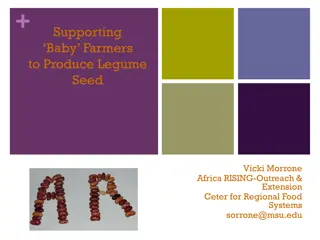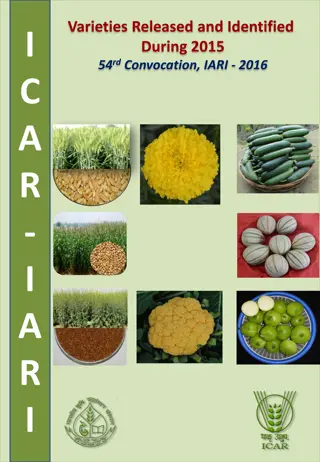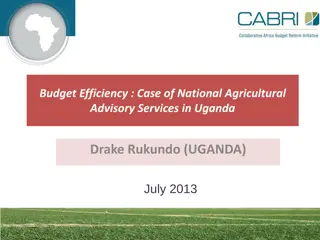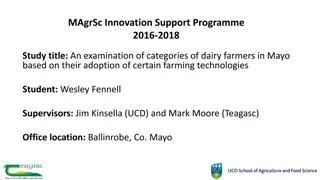Ensuring Success in Agricultural Research Trials: A Guide for Farmers
Explore the key steps involved in conducting research trials for testing new agricultural products and techniques. Learn from experts on how to plan, commit, and avoid wasted efforts in your farm experiments. Discover the significance of trial biostimulants, fertilizers, biopesticides, and chemical pesticides in enhancing farm productivity. Gain insights into identifying research questions, developing hypotheses, experimental designs, data collection, analysis, interpretation, and drawing conclusions for effective decision-making in farming practices.
Download Presentation

Please find below an Image/Link to download the presentation.
The content on the website is provided AS IS for your information and personal use only. It may not be sold, licensed, or shared on other websites without obtaining consent from the author.If you encounter any issues during the download, it is possible that the publisher has removed the file from their server.
You are allowed to download the files provided on this website for personal or commercial use, subject to the condition that they are used lawfully. All files are the property of their respective owners.
The content on the website is provided AS IS for your information and personal use only. It may not be sold, licensed, or shared on other websites without obtaining consent from the author.
E N D
Presentation Transcript
Testing New Products: How Do You Know it REALLY worked??? Drs. Chevonne Carlow and Sarah Jandricic, OMAFRA
Research Trials Let you be SURE about new products / techniques for YOUR farm Require PLANNING and COMITTMENT to not waste your efforts o Extra time, labour, money
Why Trial Biostimulants? Biostimulants / Fertilizers CFIA Biopesticides / Chemical pesticides Health Canada Registered by Composition Product safety Quality control procedures Composition Product safety Data needed Quality control procedures Environmental toxicity Efficacy against specific pests In house Often independent Data generated Relatively quick Very slow Time to market
Outline 10 Basic Steps in a Research Project Identify your research question and objective. Develop a research hypothesis. Decide what you will measure and what data you will collect. Develop an experimental design. Choose the location and map out your field plots. Implement the project. Make observations and keep records throughout the season. Collect research data. Analyze the data. 1. 2. 3. 4. 5. 6. 7. 8. 9. 10. Interpret the data and draw conclusions. Source: SARE Grant Learning Centre
Outline 10 Basic Steps in a Research Project 1. 2. 3. 4. 5. 6. 7. 8. 9. 10. Interpret the data and draw conclusions. Identify your research question and objective. Develop a research hypothesis. Decide what you will measure and what data you will collect. Develop an experimental design. Choose the location and map out your field plots. Implement the project. Make observations and keep records throughout the season. Collect research data. Analyze the data. Source: SARE Grant Learning Centre
Identifying your Question The most important part of any experiment! Don t expect one project to answer all of your questions BUT Do expect one project to lead to many more questions!
Identifying your Question I would like to see if ________ will help to ________ in ________.
Identifying your Question BioStimulants I would like to see if ________ will help to ________ in ________. Improve profits Crop X Variety Y Field Z Propagation
Identifying your Goals General Question: Biostimulants I would like to see if ________ will help to ______ __ in ________. Improve Profits Crop X Narrow Down SPECIFICHypothesis more measurable Example Hypotheses: Biostimulant X will increase yields by an average of at least 5% compared to my current production practices. Biostimulant Y will increase the percentage of fruit given top grade over my current methods Biostimulant Z will increase biomass of my cover crop and improve soil N levels, reducing the amount of fertilizer needed.
Outline 10 Basic Steps in a Research Project Identify your research question and objective. Develop a research hypothesis. Decide what you will measure and what data you will collect. Develop an experimental design. Choose the location and map out your field plots. Implement the project. Make observations and keep records throughout the season. Collect research data. Analyze the data. 1. 2. 3. 4. 5. 6. 7. 8. 9. 10. Interpret the data and draw conclusions. Source: SARE Grant Learning Centre
Getting Started: Data Collection Decide what data to collect BEFORE you set up your experiment Does it answer your QUESTION? How many samples will you need to collect to SEE A DIFFERENCE Informs layout, size of plots, labour, TIME
Getting Started: Data Collection Decide what data to collect BEFORE you set up your experiment Does it answer your QUESTION? How many samples will you need to collect to SEE A DIFFERENCE Informs layout, size of plots, labour, TIME Most Informative Most time consuming Least Informative Least time consuming Examples of Measurements: Quantitative Research Question: Biostimulant X improves crop Y Quantitative Qualitative Qualitative Plant biomass Yield Rating Scale Photo analysis
Collecting Data: A Note on Bias Do you see what you expected? Does it influence how you take data? Or how you interpret the results? Too much focus on what you expect to see, can cause you to miss interesting results!
Outline Identify your research question and objective. Develop a research hypothesis. Decide what you will measure and what data you will collect. Develop an experimental design. Define treatments Variables Replication Blocking Randomization Choose the location and map out your field plots. Implement the project. Make observations and keep records throughout the season. Collect research data. Analyze the data. 10. Interpret the data and draw conclusions. 1. 2. 3. 4. Are your results REAL or just due to CHANCE??? o o o o o 5. 6. 7. 8. 9.
Experimental Design Treatments Treatment = What you re applying to the crop; COMPARISONS of interest Different Biostimulant products Different rates of Biostimulants Different Biostimulant regimes
Experimental Design - Treatments Selecting Treatments: Keep the Trial Manageable Paired comparison (2 TREATMENTS only) E.g. Something NEW vs a CONTROL Plots/Rows Biostimulant X Control Paired comparison
Experimental Designs - Treatments Selecting Treatments: Keep the Trial Manageable Paired comparison (TWO TREATMENTS) E.g. Something NEW vs a CONTROL Plots/Rows Biostimulant X Control What you re already doing! Keep ALL other management practices (VARIABLES) the same: - Tillage - Irrigation - Pesticide applications Paired comparison
Choosing a Product Why re-invent the wheel? Use other sources to narrow it down Data on a SIMILAR crop? Region? Independent studies? Neighbours? Talk to company reps want to ensure your success!
A BIG Variable Product Quality Remember, these are LIVE organisms! Quality control is important FRESH product (check expiry date!) Proper STORAGE Proper APPLICATION
A BIG Variable Product Quality Remember, these are LIVE organisms! Quality control is important Testing?????
Outline Identify your research question and objective. Develop a research hypothesis. Decide what you will measure and what data you will collect. Develop an experimental design. Define treatments Variables Replication Blocking Randomization Choose the location and map out your field plots. Implement the project. Make observations and keep records throughout the season. Collect research data. Analyze the data. 10. Interpret the data and draw conclusions. 1. 2. 3. 4. Are your results REAL or just due to CHANCE??? o o o o o 5. 6. 7. 8. 9.
Experimental Design: Replication = Number of times the treatment is in the field WHY Replicate? lets you figure out if what you see is caused by: NATURAL VARIATION or your TREATMENT
Experimental Design: Replication HOW MANY TIMES SHOULD YOU REPLICATE? MORE IS BETTER IDEAL: 3-5 replicates per treatment SIZE MATTERS E.g. Corn: BLOCK 1 Each plot needs to yield 1000 lbs of harvested material BLOCK 2 - Will depend on equipment size BLOCK 3
Experimental Design: Randomization Assigning treatments to plots WITHOUT BIAS - Also helps reduce variation (noise) BLOCK 1 BLOCK 2 BLOCK 3
Experimental Design: Blocking Blocking Is your Field perfectly uniform? No? Then you need to block Helps reduce noise (variability) Field conditions should be uniform WITHIN each block BLOCK 1 Wet part of field BLOCK 2 BLOCK 3 All in shade
Experimental Design: Blocking Blocking Is your Field perfectly uniform? No? Then you need to block Helps reduce noise (variability) Field conditions should be uniform WITHIN each block BLOCK 1 Examples of variation to block against: - Shade - Slope - Soil texture - Wetness - Ajacent crops/wildlands BLOCK 2 BLOCK 3
Experimental Design: Blocking Helps Eliminate Sources of Variation: - Requires pre-mapping of field - Trick: lay out blocks 90 degrees to source of noise Slope = variation Block position
Outline 10 Basic Steps in a Research Project Identify your research question and objective. Develop a research hypothesis. Decide what you will measure and what data you will collect. Develop an experimental design. Choose the location and map out your field plots. Implement the project. Make observations and keep records throughout the season. Collect research data. Analyze the data. 1. 2. 3. 4. 5. 6. 7. 8. 9. 10. Interpret the data and draw conclusions. Source: SARE Grant Learning Centre
Interpreting your Data Data analysis does NOT have to be overly complicated
Interpreting your Data: GRAPH IT STEPS 1& 2 - Calculate AVERAGE within each treatment and STANDARD ERROR - GRAPH (need to make a graph in Excel with separate SE bars for each treatment) Bemisia Nymphs / Leaf 35 Swirskii Limonicus Mean number of Bemisia per leaf 30 25 20 15 10 5 Photo: U. Florida 0
Interpreting your Data: GRAPH IT STEPS 1& 2 - Calculate AVERAGE within each treatment and STANDARD ERROR - GRAPH (need to make a graph in Excel with separate SE bars for each treatment) Bemisia Nymphs / Leaf 35 Swirskii Limonicus Standard Error Mean number of Bemisia per leaf 30 The bigger the standard error, the more variation (noise) around your treatment mean 25 20 15 10 5 Photo: U. Florida 0
Interpreting your Data: GRAPH IT STEPS 1& 2 - Calculate AVERAGE within each treatment and STANDARD ERROR - GRAPH (need to make a graph in Excel with separate SE bars for each treatment) Bemisia Nymphs / Leaf 35 Swirskii Limonicus The bigger the standard error, the more variation (noise) in your treatment Mean number of Bemisia per leaf 30 25 20 Mean is less representative of what s likely to happen 15 10 5 Photo: U. Florida 0
Interpreting your Data: GRAPH IT Photo: U. Florida
Interpreting your Data: GRAPH IT Resources: - Ready-made spreadsheets for mean + SE - swroc.cfans.umn.edu/farm-trials-worksheet - YouTube tutorials for graph with separate standard error bars: - Excel 2010: youtube.com/watch?v=N1xwu8eSk7k - Excel 2013+: youtube.com/watch?v=AfAG61UWsWA Photo: U. Florida
Interpreting your Data: Compare STEP 3: COMPARE your data - A) Simple methods Likely significantly different: i.e. one treatment was better Likely NOT significantly different: i.e. NO treatment differences Photo: U. Florida Significant Difference" = results seen are most likely NOT due to chance or natural variation
Interpreting your Data: Compare STEP 3: COMPARE your data - A) Simple methods (but may conclude differences are there when they are not - B) More Involved,i.e. use statistical tests (can be more sure that results mean something) Time to run a t-test! Takes into account means, degree of overlap Calculates how certain we can be that there is a significant difference Photo: U. Florida
Statistics: not just for dorks T-test: WHY WE HAVE GOOD BEER William Sealy Gosset inventor of the t-test and why Guinness is successful
Outline 10 Basic Steps in a Research Project Identify your research question and objective. Develop a research hypothesis. Decide what you will measure and what data you will collect. Develop an experimental design. Choose the location and map out your field plots. Implement the project. Make observations and keep records throughout the season. Collect research data. Analyze the data. 1. 2. 3. 4. 5. 6. 7. 8. 9. 10. Interpret the data and draw conclusions. Source: SARE Grant Learning Centre
Interpreting your Data: The Big Picture STEP 4: Do an ECONOMIC analysis Biostimulant Trial Benefits Goal Effects Considerations Reduce crop susceptibility to stress Quantifiable Fewer losses ($) Lower IPM costs ($) Market expansion ($) Cost of Product ($) Cost of Application ($) Non- Quantifiable: Greater piece of mind Sustainability Photo: U. Florida Cost per crop? Per row? Per bushel? Cost of being wrong???
Greenhouse Example Week Crop 11020 30 40 50 Crop 1 1,289,741 (incl, 2", 4" and 6" and 8") Crop 2 58,104 (4 - 26,588) (6 31,516) Crop 3 32,025 Crop 4 27,967 (incl 4 and 6 ) Crop 5 15,329 Crop 6 7,757 (incl. 8 and 10 ) Crop 7 22,151 Crop 8 72,440 (incl. 4 and 6 ) Crop 9 29,782
Biocontrol costs by crop Crop 8, $27.4 Crop 7, $669.56 Crop 1, $2182.4 Crop 6, $3861.57 Crop 5, $1294.17 Crop 2, $5842.33 Crop 4, $6267.00 Crop 3, $3103.52
$0.90 2014 Biocontrol costs/plant $0.80 $0.70 $0.60 $0.50 $0.40 $0.30 $0.20 $0.10 $0.00 Crop 1 Crop 2 Crop 7 Crop 3 Crop 4 Crop 6 Crop 5
Managing Expectations So you didn t see much difference .. Effects of most Biostimulants are likely more subtle than things like changing pesticides or varying NPK Likely require MULTI-YEAR trials; pool data
When Good Research Goes Bad Welcome to research! Can you still reach a conclusion? The take away: Did you try to do too much? Does it give you guidelines for what not to do ?
Resources YOUR OMAFRA crop specialist Ian MacDonald, OMFRA Applied Research Coordinator ian.mcdonald@ontario.ca https://www.sare.org/Learning-Center/Bulletins/How-to-Conduct- Research-on-Your-Farm-or-Ranch/Text-Version Video Series, Conducting on Farm Research, Univ. of Nebraska CropWatch: https://www.youtube.com/playlist?list=PLdssrgg38jJ2Qaf3heqE_ne6e cce-j7ud





